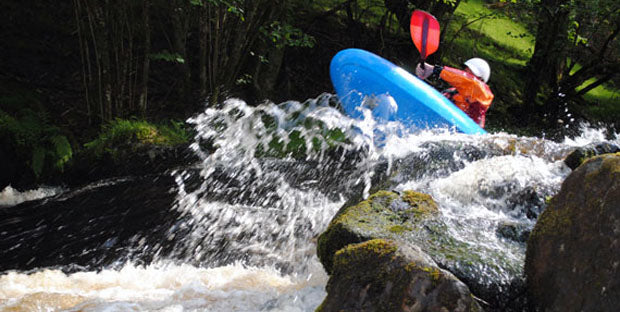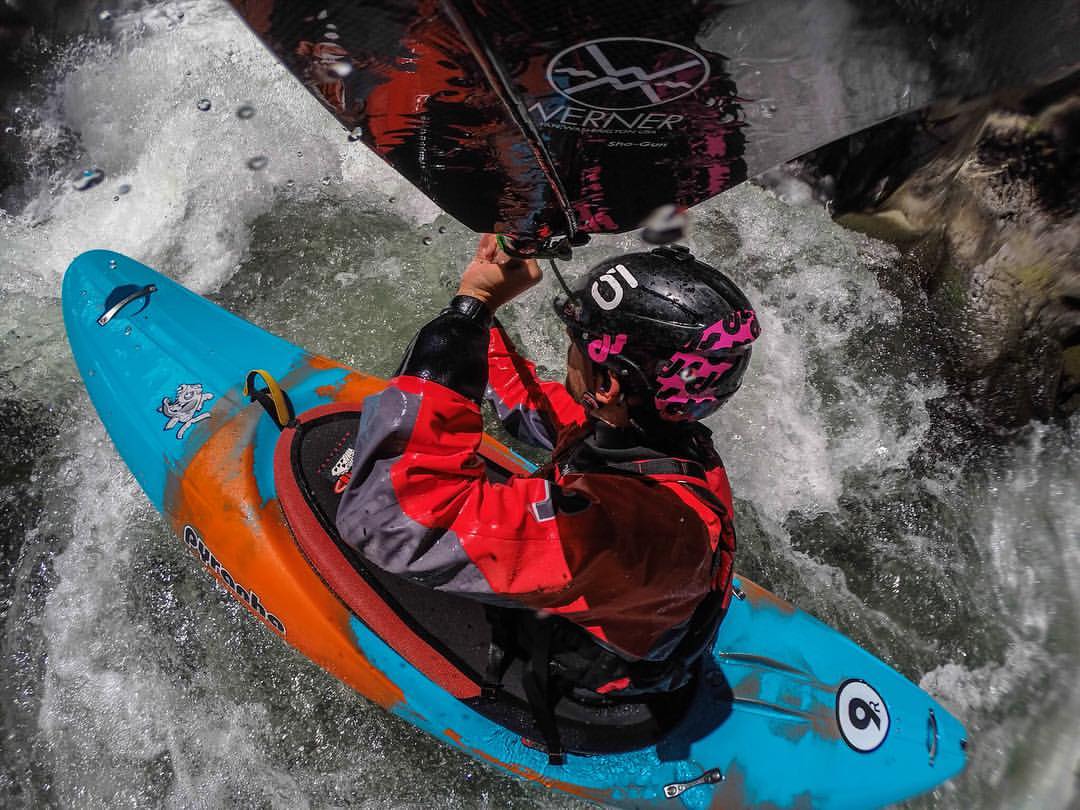Pyranha Nano Review
Pyranha's been on a winning streak lately. Since Robert Peerson joined the team, good things have happened. They released a creeker (Shiva) that just plain crushes it, and have a play boat (Jed) that rivals the best of the best. With that being said, we were not at all surprised when we caught wind of a hot new design at Outdoor Retailer this summer. The Pyranha Nano is a niche boat, that looks like it could be a ton of fun on your local river or creek. Traditionally free runners have taken on play boat volume distribution and shape, with a little more room in the stern, bow and knee wells. They also have a few extra inches in length (compared to play boats). The 2013 Pyranha Nano presents a new angle on the free runner genre. It's a voluminous, creeky looking boat, sporting a pretty radical hull. Out initial impression of this boat, is that it would be a blast to paddle on just about any run that has surf waves, rock splats, boofs, technical class IV drops, slides, micro eddies and wave trains for kick flips. Since the boat arrived during the doldrums of our off season, we contacted Robert Peerson who designed the boat, and asked him some questions that would hopefully shed some light on the form and function of this cool design. Here's what he had to say... 1.) Where did the name come from? Who named it?
The name Nano came from a long list of potential names we have saved throughout the years. The consensus here was that Nano sounded like a good mix between the Micro and Ammo which were hulls that inspired the Nano.
2.) What are the key differences between the Nano and Ammo?
The rocker profile of the Nano is more progressive and lower to maximize hull speed. There is more planning surface area in the Nano and the rails are shaped more like the Jed to tap into better play performance. The side walls are more forgiving and the deck is rounded which aids in shedding water and rolling.
3.) How playable is the Nano? What moves are possible? What's the ideal run for the Nano?
Pulling design elements from the Jed the Nano has a very playful hull capable of surfing, carving and spinning on a wave. Although it is not capable of the latest performance hole moves it can open up a whole new type of playing on your favorite creek run with rock spins, rock/wave wheels, catching tight eddies and anything else you want to try and pull off.
What is great about the Nano is that it is not contained to any one ideal run and is open for interpretation. It could be a higher volume play run where you want to play but also stay dry and upright through the harder drops. It could be a low volume tight creek or a local creek run that you have run a hundred times and want to try something new.
4.) How creekable is this boat? Class V?
The Nano has been designed to handle a lot of creeking situations and some testing was done creeking on the Green. The Shiva inspired bow softens landings while keeping the bow up and predictable when resurfacing. It boofs incredibly well and has a snappy feel peeling in and out of eddies. Although this boat is capable of Class V the short length limits the amount of volume it can hold. Some Class V situations would be better suited in a larger volume boat.
5.) Exactly who is this boat designed for? What type of paddler? Is it a niche quiver boat for someone who has a creeker and play boat? Or a boat for someone who wants to own just one boat...
This boat is designed for the beginner learning to roll all the way up to the experienced boater. It could be a single boat if you are not interested in the latest freestyle moves or stomping the hardest Class V runs and want a dry comfortable ride that is easy to roll and capable of challenging all river conditions. The Nano could also complement your quiver and give your local run a whole new perspective.
6.) Where did the design inspiration come from? Did any team paddlers help with idea? Was it your baby?
While designing and testing the Shiva I paddled the Micro quite a bit on numerous runs. That led into a few Green runs in the Ammo and I was surprised the amount of play it opened up on the river and how much fun it was to paddle. The initial thoughts were to design a creekers play boat. After paddling the first prototype the design developed into a well-rounded creek river runner for all skill levels. The Pyranha team plays an important role in the development process. Dave Fusili and several other team members were fans of the Ammo and had insightful feedback on development of the Nano.
7.) The boat looks like a blend of a few different Pyranha's? What models of other boats are incorporated into this one?
The Nano is a blend of design elements from the Shiva, Jed, Micro, Ammo and Burn.
8.) Is shorter better? Why?
A shorter hull can be better in some situations just like a longer hull can be better in others. A shorter hull can be easier to fit into tight creeking situations and fun to catch micro eddies. A shorter hull can also be easier and faster to rotate and maneuver on a river. Shorter can be easier to handle and travel with and can also be lighter.
9.) Tell us about the hull (rocker profile, if it is loose or not, etc). It looks unique - and even has the InaZon'ish channels on the stern...What are key features about the hull that consumers would want to know about.
The progressive rocker has been kept low to maintain as much speed as we can get out of the short length. The rails are kept wide for carving as well as maximizing planning surface to break free and spin on a wave. The bow is a mix of a rounded hull for soft landings and a release edge for spinning. The rails in the stern break and lead into a softer section for forgiveness and predictability.
1.) Where did the name come from? Who named it?
The name Nano came from a long list of potential names we have saved throughout the years. The consensus here was that Nano sounded like a good mix between the Micro and Ammo which were hulls that inspired the Nano.
2.) What are the key differences between the Nano and Ammo?
The rocker profile of the Nano is more progressive and lower to maximize hull speed. There is more planning surface area in the Nano and the rails are shaped more like the Jed to tap into better play performance. The side walls are more forgiving and the deck is rounded which aids in shedding water and rolling.
3.) How playable is the Nano? What moves are possible? What's the ideal run for the Nano?
Pulling design elements from the Jed the Nano has a very playful hull capable of surfing, carving and spinning on a wave. Although it is not capable of the latest performance hole moves it can open up a whole new type of playing on your favorite creek run with rock spins, rock/wave wheels, catching tight eddies and anything else you want to try and pull off.
What is great about the Nano is that it is not contained to any one ideal run and is open for interpretation. It could be a higher volume play run where you want to play but also stay dry and upright through the harder drops. It could be a low volume tight creek or a local creek run that you have run a hundred times and want to try something new.
4.) How creekable is this boat? Class V?
The Nano has been designed to handle a lot of creeking situations and some testing was done creeking on the Green. The Shiva inspired bow softens landings while keeping the bow up and predictable when resurfacing. It boofs incredibly well and has a snappy feel peeling in and out of eddies. Although this boat is capable of Class V the short length limits the amount of volume it can hold. Some Class V situations would be better suited in a larger volume boat.
5.) Exactly who is this boat designed for? What type of paddler? Is it a niche quiver boat for someone who has a creeker and play boat? Or a boat for someone who wants to own just one boat...
This boat is designed for the beginner learning to roll all the way up to the experienced boater. It could be a single boat if you are not interested in the latest freestyle moves or stomping the hardest Class V runs and want a dry comfortable ride that is easy to roll and capable of challenging all river conditions. The Nano could also complement your quiver and give your local run a whole new perspective.
6.) Where did the design inspiration come from? Did any team paddlers help with idea? Was it your baby?
While designing and testing the Shiva I paddled the Micro quite a bit on numerous runs. That led into a few Green runs in the Ammo and I was surprised the amount of play it opened up on the river and how much fun it was to paddle. The initial thoughts were to design a creekers play boat. After paddling the first prototype the design developed into a well-rounded creek river runner for all skill levels. The Pyranha team plays an important role in the development process. Dave Fusili and several other team members were fans of the Ammo and had insightful feedback on development of the Nano.
7.) The boat looks like a blend of a few different Pyranha's? What models of other boats are incorporated into this one?
The Nano is a blend of design elements from the Shiva, Jed, Micro, Ammo and Burn.
8.) Is shorter better? Why?
A shorter hull can be better in some situations just like a longer hull can be better in others. A shorter hull can be easier to fit into tight creeking situations and fun to catch micro eddies. A shorter hull can also be easier and faster to rotate and maneuver on a river. Shorter can be easier to handle and travel with and can also be lighter.
9.) Tell us about the hull (rocker profile, if it is loose or not, etc). It looks unique - and even has the InaZon'ish channels on the stern...What are key features about the hull that consumers would want to know about.
The progressive rocker has been kept low to maintain as much speed as we can get out of the short length. The rails are kept wide for carving as well as maximizing planning surface to break free and spin on a wave. The bow is a mix of a rounded hull for soft landings and a release edge for spinning. The rails in the stern break and lead into a softer section for forgiveness and predictability.
 The progressive rocker and bow/stern volume will cause the Nano to feel right at home on low volume, technical runs - and other places that traditional free runners would have a hard time.
The progressive rocker and bow/stern volume will cause the Nano to feel right at home on low volume, technical runs - and other places that traditional free runners would have a hard time.CLICK HERE TO PURCHASE A 2013 PYRANHA NANO - AND RECEIVE OVER $100 IN CKS STORE CREDIT!







